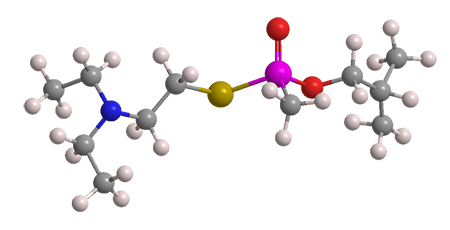What molecule am I?


You’ve undoubtedly heard or read about the attempted assassination of a former Russian spy and his daughter in England last month. The compound responsible for poisoning them was the nerve agent VR, a member of the Novichok family of extremely toxic thiophosphonate esters.
VR, also known as Russian VX or R-VX, is a high-boiling, oily liquid. It is a structural isomer of, and has properties similar to, the older, better-known agent VX. These poisons are often referred to as “nerve gases”, but inhaling the vapors and absorbing it through the skin are equally lethal.
VR, like VX, is a cholinesterase inhibitor. The toxin disables the enzyme that the nervous system uses to prevent acetylcholine buildup, which severely overstimulates muscles, causing paralysis and eventually death by asphyxiation. VR’s “advantage” over VX is that it gives a smaller time window for treating affected individuals.
The low volatility of VR causes it to be highly persistent in the environment, endangering all who come near to it. The Soviet Union began to develop VR in the 1950s and by the 1970s had produced more than 15,000 tons of the chemical. Although most of it has been destroyed, post–Soviet Union Russia reportedly maintains a supply of the agent.
VR is considered to be a military weapon, not to be used outside a military setting. For additional information see Army Regulation 385-61, The Army Chemical Agent Safety Program ; Department of the Army Pamphlet 385-61, Toxic Chemical Agent Safety Standards; and Department of the Army Pamphlet 40-8, Occupational Health Guidelines for the Evaluation and Control of Occupational Exposure to Nerve Agents GA, GB, GD, and VX.
For a more extensive history of VR, see Mark Peplow’s article in C&EN.
VR hazard information*
| GHS classification**: acute toxicity, oral, category 1 | |
| H300—Fatal if swallowed | |
| GHS classification: acute toxicity, dermal, category 1 | |
| H310–Fatal in contact with skin | |
| GHS classification: acute toxicity, dusts & mists, category 1 | |
| H330—Fatal if inhaled | |
*Based on data for VX.
**Globally Harmonized System of Classification and Labeling of Chemicals. Explanation of pictograms.
VR fast facts
| CAS Reg. No. | 159939-87-4 |
| Molar mass | 267.37 g/mol |
| Empirical formula | C11H26NO2PS |
| Appearance | Colorless to amber oily liquid |
| Melting point | 324 °C |
| Water solubility | ≈30 g/L* |
*Estimate based on VX data.
MOTW update
Last week, C&EN reported that potentially harmful volatile organic compounds (VOCs) can be emitted from the plastics used in 3-D printers. Among the VOCs are former Molecules of the Week styrene (June 8, 2015), formaldehyde (May 29, 2006), and caprolactam (September 19, 2016). Regulatory standards may be in the offing for manufacturers of these printers.

Learn more about this molecule from CAS, the most authoritative and comprehensive source for chemical information.
Molecule of the Week needs your suggestions!
If your favorite molecule is not in our archive, please send us a message. The molecule can be notable for its current or historical importance or for any quirky reason. Thank you!
Stay Ahead of the Chemistry Curve
Learn how ACS can help you stay ahead in the world of chemistry.

